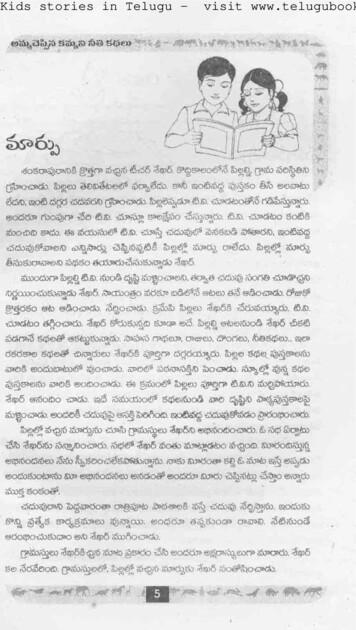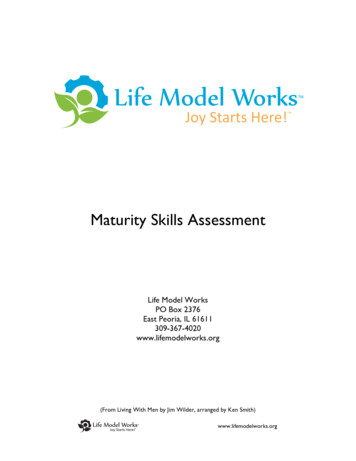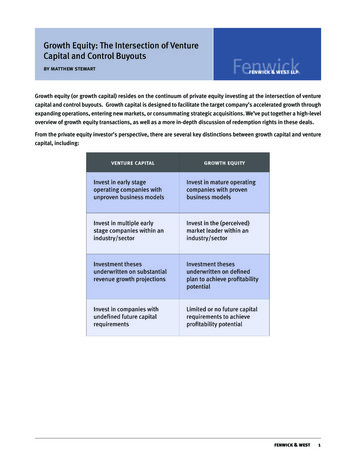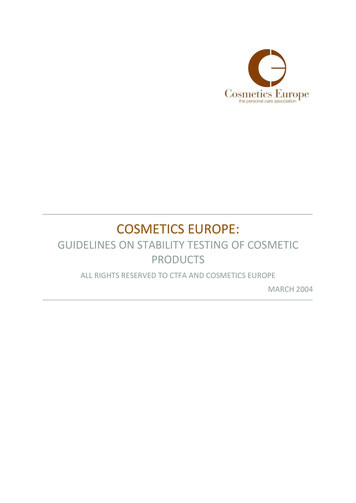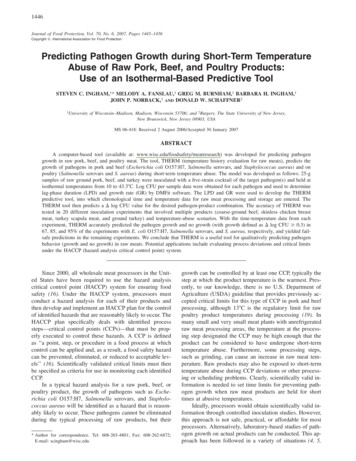
Transcription
1446Journal of Food Protection, Vol. 70, No. 6, 2007, Pages 1445–1456Copyright 䊚, International Association for Food ProtectionPredicting Pathogen Growth during Short-Term TemperatureAbuse of Raw Pork, Beef, and Poultry Products:Use of an Isothermal-Based Predictive ToolSTEVEN C. INGHAM,1* MELODY A. FANSLAU,1 GREG M. BURNHAM,1 BARBARA H. INGHAM,1JOHN P. NORBACK,1 AND DONALD W. SCHAFFNER21Universityof Wisconsin–Madison, Madison, Wisconsin 53706; and 2Rutgers, The State University of New Jersey,New Brunswick, New Jersey 08903, USAMS 06-418: Received 2 August 2006/Accepted 30 January 2007ABSTRACTA computer-based tool (available at: www.wisc.edu/foodsafety/meatresearch) was developed for predicting pathogengrowth in raw pork, beef, and poultry meat. The tool, THERM (temperature history evaluation for raw meats), predicts thegrowth of pathogens in pork and beef (Escherichia coli O157:H7, Salmonella serovars, and Staphylococcus aureus) and onpoultry (Salmonella serovars and S. aureus) during short-term temperature abuse. The model was developed as follows: 25-gsamples of raw ground pork, beef, and turkey were inoculated with a five-strain cocktail of the target pathogen(s) and held atisothermal temperatures from 10 to 43.3 C. Log CFU per sample data were obtained for each pathogen and used to determinelag-phase duration (LPD) and growth rate (GR) by DMFit software. The LPD and GR were used to develop the THERMpredictive tool, into which chronological time and temperature data for raw meat processing and storage are entered. TheTHERM tool then predicts a log CFU value for the desired pathogen-product combination. The accuracy of THERM wastested in 20 different inoculation experiments that involved multiple products (coarse-ground beef, skinless chicken breastmeat, turkey scapula meat, and ground turkey) and temperature-abuse scenarios. With the time-temperature data from eachexperiment, THERM accurately predicted the pathogen growth and no growth (with growth defined as log CFU ⱖ 0.3) in67, 85, and 95% of the experiments with E. coli O157:H7, Salmonella serovars, and S. aureus, respectively, and yielded failsafe predictions in the remaining experiments. We conclude that THERM is a useful tool for qualitatively predicting pathogenbehavior (growth and no growth) in raw meats. Potential applications include evaluating process deviations and critical limitsunder the HACCP (hazard analysis critical control point) system.Since 2000, all wholesale meat processors in the United States have been required to use the hazard analysiscritical control point (HACCP) system for ensuring foodsafety (16). Under the HACCP system, processors mustconduct a hazard analysis for each of their products andthen develop and implement an HACCP plan for the controlof identified hazards that are reasonably likely to occur. TheHACCP plan specifically deals with identified processsteps—critical control points (CCPs)—that must be properly executed to control these hazards. A CCP is definedas ‘‘a point, step, or procedure in a food process at whichcontrol can be applied and, as a result, a food safety hazardcan be prevented, eliminated, or reduced to acceptable levels’’ (16). Scientifically validated critical limits must thenbe specified as criteria for use in monitoring each identifiedCCP.In a typical hazard analysis for a raw pork, beef, orpoultry product, the growth of pathogens such as Escherichia coli O157:H7, Salmonella serovars, and Staphylococcus aureus will be identified as a hazard that is reasonably likely to occur. These pathogens cannot be eliminatedduring the typical processing of raw products, but their* Author for correspondence. Tel: 608-265-4801; Fax: 608-262-6872;E-mail: scingham@wisc.edu.growth can be controlled by at least one CCP, typically thestep at which the product temperature is the warmest. Presently, to our knowledge, there is no U.S. Department ofAgriculture (USDA) guideline that provides previously accepted critical limits for this type of CCP in pork and beefprocessing, although 13 C is the regulatory limit for rawpoultry product temperatures during processing (19). Inmany small and very small meat plants with unrefrigeratedraw meat processing areas, the temperature at the processing step designated the CCP may be high enough that theproduct can be considered to have undergone short-termtemperature abuse. Furthermore, some processing steps,such as grinding, can cause an increase in raw meat temperature. Raw products may also be exposed to short-termtemperature abuse during CCP deviations or other processing or scheduling problems. Clearly, scientifically valid information is needed to set time limits for preventing pathogen growth when raw meat products are held for shorttimes at abusive temperatures.Ideally, processors would obtain scientifically valid information through controlled inoculation studies. However,this approach is not safe, practical, or affordable for mostprocessors. Alternatively, laboratory-based studies of pathogen growth on actual products can be conducted. This approach has been followed in a variety of situations (4, 5,
J. Food Prot., Vol. 70, No. 6PREDICTING PATHOGEN GROWTH IN RAW MEATS1447TABLE 1. Chemical and physical characteristics of typical laboratory-ground pork, beef, and turkey used to develop THERM andcommercial coarse-ground beef, skinless chicken breast meat, turkey scapula meat, and ground turkey used in experiments to testTHERMAnalysisLaboratoryground porkLaboratoryground beefCoarse-groundbeefLaboratoryground turkeySkinlesschickenbreastsTurkeyscapula meatPlant APlant BapH% moisture% fat% protein% salt5.773.91.723.6 .99.618.20.16.169.712.617.20.3aCommercial ground turkeyThe product contained added rosemary extract preservatives.7, 8). Another possible way to generate the needed information is to analyze the processing time-temperature conditions by computer-generated predictive models of pathogen growth. For example, pathogen growth during nonisothermal temperature abuse could be predicted by dividing the product time-temperature history into multiple smalltemperature-change intervals and then applying the USDAPathogen Modeling Program (PMP 7.0, Agricultural Research Service, Eastern Regional Research Center, Wyndmoor, Pa.) to predict the pathogen growth in each interval.The estimated pathogen growth would be the sum of thepredicted growth for each interval. However, because manyof the PMP 7.0 models are derived from studies with purepathogen cultures in laboratory media, USDA regulatorshave not generally accepted this approach as the sole meansof scientific validation (20). In contrast, the AgriculturalResearch Service, Eastern Regional Research Center, hasdeveloped a tool for predicting E. coli O157:H7 growth thatis based on experiments with sterile ground beef (14). Thistool, although based on studies with meat, does not accountfor potential growth-affecting interactions between E. coliO157:H7 and nonpathogenic bacteria indigenous to commercial products.A more versatile, low-cost alternative to pathogen challenge studies and existing predictive tools is the development of a computer-generated predictive tool based onpathogen growth data obtained from multiple inoculationstudies conducted with nonsterile, raw ground pork, beef,and poultry. By this approach, the growth predictionswould be based on the observed behavior of relatively highnumbers of pathogen cells, in the absence of added inhibitory substances such as sodium chloride or sodium nitrite,and with a low, but realistic, level of competing microorganisms, i.e., a simulated ‘‘worst-case’’ situation. In an earlier study, we presented such a tool and validated its usefor predicting the growth of E. coli O157:H7, Salmonellaserovars, and S. aureus during the slow partial-cooking ofbacon (1). In the present study, we developed a tool,THERM (temperature history evaluation for raw meats), forpredicting pathogen growth in raw pork and beef (E. coliO157:H7, Salmonella serovars, and S. aureus) and on poultry meat (Salmonella serovars and S. aureus) during shortterm temperature-abuse situations. We tested the accuracyof THERM by subjecting inoculated, raw coarse-groundbeef; raw, skinless chicken breast meat; raw turkey scapulameat; and raw ground turkey to short-term temperatureabuse situations and comparing the experimentally determined pathogen growth with the level of pathogen growthpredicted by THERM.MATERIALS AND METHODSRaw ground pork, beef, and turkey used in developingTHERM. Fresh, vacuum-packaged, nonenhanced (not injectedwith phosphate solution) pork loins were obtained from a localretail store or directly from a local wholesale distributor. Fresh,vacuum-packaged beef roasts were obtained from a local retailstore. A large box of frozen, nonenhanced, skinless turkey breastswas obtained from a local wholesale distributor. Pork loins werefrozen at 20 C and then thawed at 5 C before grinding, whilebeef roasts were ground within 1 day of arrival at the laboratory.Before grinding, fat was trimmed from the pork loins and beefroasts, because high fat content may slow the growth rate (GR)of E. coli O157:H7 in raw meats (13). Turkey breasts were storedin the freezer ( 20 C) and then thawed at 5 C in preparation forgrinding. Meat was ground once with a meat grinder (a grindingplate with 4-mm-diameter holes; Univex model MG8912, Univex,Salem, N.H.).Raw meat microbiological and chemical analyses. A 25-gsample of ground meat from each purchased package or box wasplaced in a filter bag measuring 15.25 by 23 cm (6 by 9 in.) anddiluted with 99 ml of Butterfield’s phosphate diluent (BPD; Nelson Jameson, Marshfield, Wis.). The sample was then appropriately diluted in BPD and plated on 3M Petrifilm aerobic countplates (APC; 3M Microbiology, St. Paul, Minn.) and incubated at35 C for 48 h to determine the concentration of indigenous bacteria (APC) in the meat product before its use in isothermal studies. One sample each of a representative lot of ground pork,ground beef, and ground turkey was sent to a commercial laboratory for a determination of the pH, percent moisture, percentfat, percent protein, and percent salt (Table 1). Other than thesamples for APC determination and chemical analyses, the groundmeats were vacuum sealed in large plastic bags and frozen at 20 C until thawing at 5 C before use.Preparation of inocula. Five strains each of E. coli O157:H7, Salmonella serovars, and S. aureus were used in developingand testing THERM (Table 2). Each strain was prepared from afrozen stock culture, with a working culture plate prepared bysuccessively culturing twice at 35 C for 18 to 24 h in brain heartinfusion broth (Difco, Becton Dickinson, Sparks, Md.), streakingto brain heart infusion agar (Difco, Becton Dickinson), incubatingat 35 C for 18 to 24 h, examining for homogeneous colony morphology, and then storing the plate at 5 C. An isolated colony of
1448INGHAM ET AL.J. Food Prot., Vol. 70, No. 6TABLE 2. Pathogen strains used for the development and testingof THERMSource ofisolationSource ofstraina1S20Salami implicated in illnessoutbreakClinical sampleGround beef implicated in illness outbreakClinical sampleClinical sampleClinical sample,WisconsinLaboratory ofHygieneClinical sample,WisconsinLaboratory ofHygieneUnknownS21Unknown3E40Chicken ovaryisolate, NewYork Department of HealthClinical sample3Clinical sampleCake implicatedin illness outbreakTurkey salad implicated in illness outbreakGenoa salamiimplicated inillness outbreak24SpeciesStrain no.Escherichia coliO157:H7USDA-FSISb380-94E. coli O157:H7E. coli O157:H7ATCC 43894ATCC 43895E. coli O157:H7E. coli O157:H7Salmonella TyphimuriumATCC 51657ATCC 51658S9Salmonella HeidelbergS13Salmonella InfantisSalmonella HadarSalmonella EnteritidisStaphylococcusaureusS. aureusS. aureusATCC 12600ATCC 25923FRI-100S. aureusFRI-472S. aureusFRI-10072222333244a1, Dr. John Luchansky, formerly Food Research Institute, University of Wisconsin–Madison; now at USDA, Agricultural Research Service, Eastern Regional Research Center; 2, AmericanType Culture Collection, Manassas, Va.; 3, Dr. Eric Johnson,Food Research Institute, University of Wisconsin–Madison; 4,Dr. Amy Wong, Food Research Institute, University of Wisconsin–Madison.b FSIS, Food Safety and Inspection Service.each strain was transferred from its working culture plate to 9 mlof brain heart infusion broth and then incubated at 35 C for 24 h.Inocula were prepared for each pathogen by combining each ofthe five cultured strains into a 50-ml centrifuge tube and centrifuging at 5,000 g for 12 min. Because earlier studies in ourlaboratory had shown that combining all three pathogen speciessignificantly inhibited the growth of S. aureus in inoculated rawmeat (data not shown), two different inocula were prepared forthe pork and beef experiments. The first contained E. coli O157:H7 and Salmonella serovars prepared as follows: the supernatantwas decanted from each five-strain mixture, and each pellet wasresuspended to 25 ml with BPD. From both five-strain mixtures,10 ml was transferred to another 50-ml centrifuge tube, creating20 ml of a 10-strain, two-pathogen inoculum containing ca. 9 logCFU/ml. The second inoculum, containing only S. aureus at alevel of ca. 9 log CFU/ml, was prepared by decanting the supernatant from the five-strain mixture and resuspending the pellet to45 ml with BPD. Finally, each inoculum was diluted 100-fold inBPD. For experiments with turkey, the same procedure was followed, except that E. coli O157:H7 was not used.Preparation and inoculation of meat. Isothermal studieswere conducted at approximately 2.8 C intervals (actually measured as 5 F, because the U.S. meat industry uses the Fahrenheitscale) ranging from 10 to 43.3 C (50 to 110 F). Raw ground pork,beef, and turkey (ca. 25 g) were weighed out into sample bags(7.5 by 18.5 cm) and allowed to reach the test temperature eitherin a static water bath (temperatures above room temperature [RT])or an incubator (temperatures at, or below, RT). A type K thermocouple, attached to a model SP150 data logger (Dickson, Addison, Ill.), was inserted in the center of a bag of meat to determine when the test temperature had been reached. When the testtemperature was reached, each meat sample (except for the onecontaining the thermocouple) was inoculated with 100 l of (i)the E. coli O157:H7 and Salmonella serovars inoculum (beef andpork), (ii) the Salmonella serovars inoculum (turkey), or (iii) theS. aureus inoculum (all products). Previously, we determined thatpathogen growth was faster when the inoculum was dispersed inthe ground meat than when it was localized in a ‘‘hole’’ withinthe meat mass (data not shown); hence, each inoculated samplebag was sealed and manually massaged for 20 s to distribute theinoculum throughout the meat mass. Bags of inoculated productwere returned to the isothermal experiment temperature as quicklyas possible ( 5 min). Three concurrent trials were conducted foreach temperature, with separate inocula prepared for each trial,and enough bags of inoculated product were prepared to allow ananalysis of one bag for each inoculum type in each trial at everysampling time.Enumeration of inoculum organisms. In experiments to develop THERM, three bags per inoculum type (one per trial) wereremoved at each sampling time from the water bath or incubator.The outer surface of each bag was sanitized with 70% ethanol andallowed to dry. Once dry, the contents of each bag were transferred to a filter bag measuring 15.25 by 23 cm. The originalsample bag was everted to expose any inoculum still on the bagand was also placed into the filter bag. The ground meat sampleand original sample bag were combined with 99 ml of BPD, stomached at normal speed for 30 s with a stomacher laboratory blender (Fisher Scientific, Itasca, Ill.), and serially diluted (in BPD).Similar sampling and initial sample homogenization were done ateach sampling time in experiments to test THERM (see below).For each dilution, 100 l was spread on a single plate with asterile, bent, plastic spreader. The selective medium used for E.coli O157:H7 was sorbitol MacConkey agar (Difco, Becton Dickinson) on which typical colonies are colorless to white andopaque. The selective medium used for the Salmonella serovarswas xylose lysine decarboxylase agar (Oxoid, Ogdensburg, N.Y.)on which typical colonies have a black center and a well-definedclear-to-opaque halo. The selective medium used for S. aureuswas Baird-Parker agar base (Difco, Becton Dickinson) with a tellurite egg yolk supplement (Difco, Becton Dickinson). Typical S.aureus colonies on Baird-Parker agar base are shiny black with adistinctive clear zone in the surrounding agar. The sorbitolMacConkey agar and xylose lysine decarboxylase plates were incubated at 35 C for 24 h, and the Baird-Parker agar plates were
J. Food Prot., Vol. 70, No. 6PREDICTING PATHOGEN GROWTH IN RAW MEATS1449TABLE 3. Ground pork: observed lag-phase duration (LPD), growth rate (GR), and R2 values (derived by DMFit) for E. coli O157:H7 (EC), Salmonella serovars (SALM), and S. aureus (SA)aECSALMTemp( C/ F)LPD(min)GR(log CFU/min)R2LPD(min)GR(log in)GR(log 980.840.960.870.96Indigenous microbial load before inoculation was ⱕ3.5 log CFU/g.NG, no growth.perature into the DMFit 1.0 program (J. Baranyi, Institute of FoodResearch, Norwich Research Park, Norwich, UK), which generated a best-fit growth curve, with an estimated lag-phase duration(LPD), GR, and corresponding R2 value (Tables 3 through 5). TheLPD and GR values for each combination of pathogen and typeof raw meat were used to develop the THERM tool. Software hasbeen written that allows the user to enter up to 20 elapsed-time(expressed in minutes) and temperature (expressed in degreesFahrenheit) data pairs. This software uses an interval accumulation strategy to estimate the percentage of LPD that elapses ineach time interval (constant temperature assumed) by dividing theinterval time by the LPD and multiplying the resulting value by100. The percentage of LPD contributed by each interval is accumulated and displayed interval by interval until 100% of thetime in lag phase has elapsed (equation 1).incubated at 35 C for 48 h. After colony enumeration, one typicalcolony of each pathogen per test temperature was transferred tobrain heart infusion agar and grown overnight at 35 C for confirmation. Gram staining reaction, cell morphology, and colony morphology were observed for all isolates. A latex agglutination test(Oxoid) was also done for presumptive S. aureus. For presumptiveSalmonella serovars, the oxidase test (DrySlide kit, Fisher) andAPI 20E biochemical characterization (bioMérieux, Hazelwood,Mo.) were also done, and an oxidase test and latex agglutinationtest (Oxoid) were used to confirm presumptive colonies of E. coliO157:H7.The THERM tool. For each pathogen and test temperature,the log CFU per sample was determined at each sampling timefor each of the three trials. The sampling time and log CFU persample data were then entered for each pathogen and test tem-TABLE 4. Ground beef: observed lag-phase duration (LPD), growth rate (GR), and R2 values (derived by DMFit) for E. coli O157:H7 (EC), Salmonella serovars (SALM), and S. aureus (SA)aECSALMTemp( C/ F)LPD(min)GR(log 4abR2LPD(min)SAGR(log CFU/min)R2LPD(min)GR(log s microbial load before inoculation was ⱕ3.5 log CFU/g.NG, no growth.R2
1450INGHAM ET AL.J. Food Prot., Vol. 70, No. 6TABLE 5. Ground turkey: observed lag-phase duration (LPD),growth rate (GR), and R2 values (derived by DMFit) for Salmonella serovars (SALM) and S. aureus (SA)aSALMSATemp( C/ F)LPD(min)GR (logCFU/min)R2LPD(min)GR 0.980.770.980.970.960.980.97NGNGIndigenous microbial load before inoculation was ⱕ3.5 logCFU/g.b NG, no growth.a冘 interval time/LPD 100Ntotal % LPD (1)ii 1After the lag phase is complete, interval accumulation is used toestimate the subsequent growth, expressed in log CFU. The logCFU of growth is computed by multiplying the GR (log CFU perminute) by either the time (in minutes) remaining in the intervalduring which the lag phase ended or the total time of the interval(for all intervals thereafter; equation 2).冘 GR for interval interval timeNtotal growth i 1ii(2)Temperature was assumed to be constant throughout each interval.When temperature values entered by the user do not coincide withexperimental temperatures used (2.8 C intervals from 10 to43.3 C), linear interpolation is performed between DMFit-derivedLPD and GR values to obtain the LPD and GR values for use incalculating the predicted growth.Testing THERM performance in commercial product inoculation studies. The accuracy of THERM was tested in severalinoculation studies with coarse-ground beef, pieces of skinlesschicken breast meat and turkey scapula meat, and ground turkeymeat. These products were inoculated, subjected to various shortterm temperature-abuse regimes, and analyzed to determine pathogen populations at predetermined time points during the temperature abuse. A time-temperature history for either the product(4.5-kg chubs [vacuum-sealed cylindrical packages] of coarseground beef) or the storage environment (poultry products) wasalso obtained in each experiment to enter into THERM and obtaina predicted change in log CFU, or log CFU.Coarse-ground beef in 4.5-kg chubs was obtained from a local wholesale distributor. A representative sample was sent to acommercial laboratory for chemical and physical analysis (Table1). At the time of use, the concentration of indigenous bacteria(APC) was quantified as described earlier. Inocula for coarseground beef studies were prepared as described previously. Toinoculate the 4.5-kg chubs, twelve 25-g samples were removedfrom 12 squares measuring 3.8 by 3.8 cm made by cutting incisions through the packaging material on the top half of the longaxis of the chub. The 25-g samples were placed in small (7.5 by18.5 cm), sampling bags inoculated with 100 l of either the E.coli O157:H7 and Salmonella serovars inoculum or the S. aureusinoculum, and manually massaged for 20 s to disperse the inoculum. The inoculated samples in sample bags were flattened toattain the original dimensions (3.8 by 3.8 cm) and placed backinto the incisions (3.8 by 3.8 cm) made in the chubs, with theends of the sample bags inserted just underneath the packagingof the product. After inoculation, the surface of each 4.5-kgcoarse-ground beef chub contained six samples inoculated with E.coli O157:H7 and Salmonella serovars and six samples inoculatedwith S. aureus.Inoculated coarse-ground beef chubs were subjected to oneof three temperature-abuse situations (Table 6). For each coarseground beef experiment, a temperature probe attached to a datalogger was inserted just under the surface in the center of thechub to record the time-temperature data, which were then enteredinto THERM. Data points were selected by dividing the experiment time into 20 equal intervals and determining the temperatureat each of the times from the data logger output. In coarse-groundbeef experiments, the three temperature-abuse situations represented (i) pathogen contamination of refrigerated raw meat, followed by short-term holding (3 to 6 h) at RT or 35 C (experiments1 to 4); (ii) thawing of previously contaminated and frozen products at RT or 35 C (12 to 15 h; experiments 5 to 8); and (iii)holding of meat that had been previously contaminated, frozen,and thawed at RT or 35 C for 12 h (experiments 9 to 12). Sampling (one sample bag per inoculum) and pathogen enumerationwere done as described earlier at predetermined times throughouteach experiment. Frozen or frozen-thawed samples were spreadplated on nutrient agar (Difco, Becton Dickinson) and incubatedat 35 C for 1 h to encourage repair of freeze-thaw–induced injury,and then the nutrient agar was overlaid with the appropriate selective medium (tempered at 48 C). Incubation then continued at35 C for the usual 24- or 48-h period.Fresh, skinless chicken breasts and ground turkey meat fromtwo different processors were obtained at a local retail store andeither stored at 5 C or frozen and then thawed at 5 C before use,respectively. Frozen turkey scapula meat was obtained from a local wholesale distributor, stored frozen, and then thawed at 5 Cbefore use. A representative sample of each product was sent toa commercial laboratory for chemical and physical analysis (Table1). The APC was determined for each product as described earlier.Each type of poultry product was subdivided into small portions,inoculated with either the Salmonella serovars or the S. aureus(inoculum prepared as described previously), and then stored.Storage treatments were either at 13 C for 8 h (experiments 13 to16), mimicking a processing environment barely complying withUSDA regulations (19), or sequentially at 13 C for 3 h, 21 C for3 h, and 30 C for 4 h (experiments 17 to 20). The latter experiments mimicked an extreme loss of temperature control (e.g.,products inadvertently left on a loading dock, cooler failure).Small pieces of meat 2.5 by 2.5 by 1.8 cm thick were excisedfrom the surface of the skinless chicken breasts and from theturkey scapula meat, and 100 l of either the Salmonella serovarsor the S. aureus inoculum was pipetted onto the surface of eachpiece and distributed with a sterile plastic spreader. Each inoculated piece was placed in a sample bag (7.5 by 18.5 cm). Groundturkey meat was distributed in sample bags (7.5 by 18.5 cm; 25g per bag) and inoculated with either the Salmonella serovars orthe S. aureus as described earlier. A bag of each product for eachinoculum type was analyzed to obtain time zero inoculum levels,and all remaining bags were then stored. A thermocouple and datalogger, as described earlier, were used to monitor storage temper-
J. Food Prot., Vol. 70, No. 6PREDICTING PATHOGEN GROWTH IN RAW MEATSTABLE 6. Outline of temperature-abuse experiments with inoculated coarse-ground beef (GB), skinless chicken breasts (C), turkey scapula meat (T), ground turkey meat from plant A (GT-A),and ground turkey meat from plant B (GT-B)Expt no.ProductStorage temp ( BGBGBGBCTGT-AGT-BCTGT-AGT-BRTaRT3535 20/RT 20/RT 20/35 20/35 20/5/RT 20/5/RT 20/5/35 /305/13/21/30Holding aRT, room temperature ( 21 C).Holding time at RT, 13 C, or 35 C. Initial sampling occurred oninoculation (for nonfrozen coarse-ground beef samples), wheninoculated poultry products were moved to 13 C storage, orwhen frozen coarse-ground beef was removed from the freezer.c Sampling was done when the center of the meat mass reached5 C and perodically during storage at RT or 35 C.d The product was held at 13 C for 3 h, 21 C for 3 h, and 30 Cfor 4 h. Initial sampling was done when the product was movedto 13 C storage.bature and provide data to enter into THERM. Data points wereselected by dividing the experiment time into 20 equal intervalsand determining the temperature at each of the times from thedata logger output. One sample of each product type was analyzedat 3, 6, and 8 h (experiments 13 to 16) or at 3, 6, and 10 h(experiments 17 to 20). Microbiological analyses were conductedas described earlier.Statistical analyses. The paired t test, with a 5% significancelevel (release 12, Minitab, Inc., State College, Pa.), was done tocompare the LPD and GR values for a given pathogen betweenproducts (ground pork, ground beef, and ground turkey) and fora given product between pathogens (E. coli O157:H7, Salmonellaserovars, and S. aureus). In experiments to test THERM, each logCFU value obtained in an experiment was subtracted from itscorresponding time zero value to obtain observed log CFU values. Time-temperature data from each experiment were enteredinto THERM to obtain predicted log CFU values. The observed log CFU values were compared with the predicted values bythe paired t test and regression analysis (Minitab).RESULTS AND DISCUSSIONEarlier experiments in our laboratory showed that thelevel of indigenous microorganisms had a significant effecton the LPD values for S. aureus (data not shown) bu
ditions by computer-generated predictive models of patho-gen growth. For example, pathogen growth during non-isothermal temperature abuse could be predicted by divid-ing the product time-temperature history into multiplesmall temperature-change intervals and then applying the USDA Pathogen Modeling Program (PMP 7.0, Agricultural Re-





